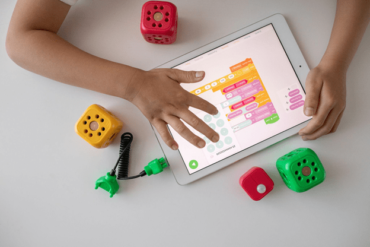Picture a classroom filled with enthusiasm, where children explore the enigmas of the cosmos, construct sky-reaching bridges, and create their own virtual realms through coding.
Welcome to the world of STEM education, where science, technology, engineering, and mathematics prosper in the hands of eager learners!
Teaching STEM to kids not only prepares them for future careers but also fosters critical thinking, problem-solving skills, and creativity. This comprehensive guide will unveil effective strategies for teaching STEM to kids.
What is STEM education for kids?
STEM education for kids is a holistic and interactive teaching and learning approach focusing on four core aspects: Science, Technology, Engineering, and Mathematics. It aims to inspire young learners, typically from early childhood through high school, to develop critical thinking, problem-solving, and creative skills by engaging with real-world concepts and hands-on activities in these subject areas.
STEM education goes beyond traditional classroom methods. It encourages exploration, experimentation, and interdisciplinary thinking, allowing children to connect concepts from various fields and apply them to practical situations.
Through STEM education, kids are exposed to various experiences, from conducting scientific experiments to building simple machines, coding computer programs, and solving complex mathematical puzzles.
Benefits of STEM education for kids
The US Bureau of Labor Statistics found that there has been a 79 per cent increase in employment in STEM fields over the last thirty years. It’s clear that the world’s demand for expertise in science, technology, engineering, and mathematics is expanding rapidly.
As such, introducing kids to STEM education offers a multitude of advantages that extend far beyond the classroom:
- Fostering critical thinking: STEM education encourages kids to analyze problems, brainstorm solutions, and think critically. They learn to approach challenges systematically, developing valuable skills applicable to everyday life
- Enhancing problem-solving skills: Engaging with STEM concepts prompts children to devise creative solutions to complex problems. This skill set equips them to address challenges in diverse fields, from designing efficient transportation systems to developing groundbreaking medical technologies
- Promoting innovation: STEM education nurtures innovation by encouraging kids to explore new ideas, experiment with various approaches, and refine their innovations based on evidence and feedback
- Building resilience: In the face of setbacks and failures, STEM education teaches kids to persevere and learn from their mistakes. This resilience is a valuable life skill that extends beyond academics
- Encouraging collaboration: Many STEM projects involve teamwork and collaborative problem-solving, helping kids develop interpersonal skills, effective communication, and working harmoniously with others
- Nurturing curiosity: STEM learning thrives on curiosity, inspiring kids to ask questions, explore, and seek knowledge independently. This curiosity-driven approach contributes to a lifelong love of learning
- Real-world applications: STEM education often involves hands-on projects that mirror real-world scenarios, enabling kids to see the practical implications of their learning and fostering a deeper understanding of concepts
- Preparing for future careers: As industries evolve, proficiency in STEM subjects becomes increasingly essential. STEM education equips kids with foundational knowledge that can lead to many exciting and well-paying careers
Image by Robo Wunderkind on Unsplash
7 Effective Strategies for Teaching STEM to Kids
Here are seven practical approaches that breathe life into STEM education, igniting a spark of wonder that can fuel a lifelong passion:
1. Hands-on experiments and activities
Engaging students in hands-on experiments and activities is a hallmark of effective STEM education. By touching, observing, and interacting with tangible materials, young learners grasp complex concepts in ways that textbooks alone cannot convey.
Whether concocting chemical reactions or building paper rockets that soar skyward, these tactile experiences cultivate a deeper understanding of STEM principles and spark a love for exploration.
2. Real-world connections
The magic of STEM lies in its theory and its tangible relevance to the world around us. Demonstrating real-world applications of STEM concepts bridges the gap between abstract theories and everyday life.
From measuring the angles of a suspension bridge to calculating the speed of a racing car, these connections unveil the practical impact of STEM subjects and nurture a sense of awe in children as they realize the role these disciplines play in shaping our world.
3. Math in nature
Nature itself is a remarkable canvas for teaching mathematics. Taking advantage of math in nature is a captivating strategy to engage kids in STEM learning.
The Fibonacci sequence manifesting in the petals of a flower, the fractal geometry of a snowflake, or the spiral patterns of shells—all reveal the profound interplay between mathematics and the natural world, inviting children to explore the harmonious relationship between numbers and nature.
4. Project-based learning
Project-based learning instils a sense of ownership and fosters critical skills when you empower kids to take the reins of their learning journey.
Whether designing a sustainable garden to understand ecological systems or constructing a miniature model of a solar-powered city, these hands-on projects stimulate independent thinking, teamwork, and problem-solving prowess. Project-based learning deepens their comprehension of STEM concepts and nurtures their ability to tackle complex challenges creatively.
5. Inquiry-based approach
Curiosity is the compass that guides a child’s quest for knowledge. By embracing an inquiry-based approach, you encourage kids to ask questions, seek answers, and explore avenues of their interest.
This dynamic learning method transforms the classroom into a haven of curiosity, where young minds become detectives uncovering the mysteries of the universe. This approach encourages children to ask “why” and “how,” propelling them into the heart of STEM, where they develop critical thinking and a thirst for discovery.
6. Arts integration
Marrying art with STEM to create the STEAM approach infuses creativity into the educational journey. Incorporating elements of art—be it through sketching scientific diagrams, composing music inspired by mathematical patterns, or crafting visual representations of engineering marvels—adds a vibrant layer to STEM subjects.
This interdisciplinary fusion nurtures imaginative thinking, encourages diverse perspectives, and underscores the idea that creativity and innovation are inseparable companions in discovery.
7. Celebrate achievements
As children embark on their exploration of STEM, celebrating their achievements and nurturing their curiosity is paramount.
Recognizing their efforts, no matter how small reinforces their sense of accomplishment and encourages them to push their boundaries further. Establishing an environment where questioning is championed, and mistakes are recognized as stepping stones to growth fosters a positive mindset and empowers kids to embrace the challenges that STEM presents fearlessly.
These strategies aren’t just tools; they’re keys to igniting curiosity, creativity, and a lifelong love for learning. Let’s journey forward, confident that the seeds of passion you plant today will shape a brilliant tomorrow!
- 50+ Heartfelt Holi Wishes For Your Loved Ones - March 19, 2024
- Holi Games for Kids: Exciting Outdoor and Indoor Activities for a Joyous Celebration - March 19, 2024
- 5 Delicious Best Holi Festival Recipes - March 19, 2024
- Keeping Your Pregnancy Positive - February 26, 2024
- Crafting A Medical School Path: Tips For Parents - January 24, 2024
- Guide To Managing Twin Babies With Ease - January 3, 2024
- 5 Tips To Be A Happy Special Needs Mommy - January 3, 2024
- DIY Ideas To Decorate Kids’ Room - January 3, 2024
- Tips To Use Mindful Parenting In Today’s Time - January 3, 2024
- 7 Pregnancy Tips To Consider For An Expecting Mom - January 2, 2024
















